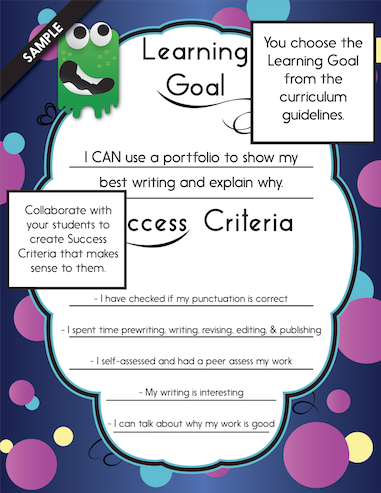Learning Goals & Success Criteria
THE ART OF CO-CREATING STEPS TO SUCCESS IN LEARNING
What are learning goals and success criteria?
 LEARNING GOALS:
LEARNING GOALS: These come from the curriculum documents. They describe what students are expected to know, understand, and be able to accomplish when an instructional period is complete, whether that be a lesson, unit, or course.
SUCCESS CRITERIA:
These are the specific ways of obtaining the learning goals. They are concrete examples of what the learning goal looks like. These are the specifics that we are looking for when assessing and evaluating students. Success criteria enhance the ability of students to perform self and peer assessments. The important thing to remember is that this is written in kid language and is created with the students.
Why do we co-create the success criteria with our students?
It's important to make learning relevant to your students. They need to feel like they are taking an active part in their learning. Creating success criteria with your students helps them to really understand what successful learning looks like and what their teacher is looking for.
How do I go about creating learning goals and success criteria?
STEP 1:
- Review the overall expectations
- Choose a specific expectation to focus on
STEP 2:
- The specific expectation becomes your learning goal, but you need to write it in language that your students will understand
- Record your learning goal on a poster that you will display in your classroom
This is not displayed to the students, but is relevant in creating the learning goal and success criteria.
OVERALL EXPECTATION: LANGUAGE - WRITING
3. Use editing, proofreading, and publishing skills and strategies, and knowledge of language conventions, to correct errors, refine expression, and present their work effectively
SPECIFIC EXPECTATION: PUNCTUATION - 3.4
Use punctuation to help communicate their intended meaning, with a focus on the use of: a capital letter at the beginning of a sentence; a period, question mark, or exclamation mark at the end
STEP 3:
- Display the poster in your classroom and present it to your students
- Talk about the learning goal and brainstorm ways for your students to show that they understand the learning goal
- Record these ways of showing that they understand the learning goal in kid language (these are the success criteria)

EXAMPLE:
LEARNING GOAL: I CAN use punctuation correctly in my sentences.
SUCCESS CRITERIA:
- I use capital letters at the beginning of my sentence
- I use a period at the end of my sentence
- I use a question mark at the end of a question
- I use an exclamation mark to show excitement

STEP 4:
- Introduce the activity that will allow your students to learn about the learning goal and show what they know
- Give students the opportunity to self-assess using their success criteria
 |
| **FREEBIE** from Little Monsters Classroom |
- Make a habit of using learning goals and success criteria with your students
- Encourage students to take charge of their learning and to constantly self-assess by asking themselves if they are completing the success criteria that they helped to develop
- Keep track of the curriculum expectations that you are covering and the learning goals and success criteria that you and your students co-created
- Post your learning goals and success criteria posters around the classroom for future reference
- Create and post posters for ongoing activities (daily writing and reading activities) so that students are always able to self-assess
